AMD Announces Ryzen Threadripper Pro: Workstation Parts for OEMs Only
by Dr. Ian Cutress on July 14, 2020 12:30 PM EST
Last year we spotted that AMD was in the market to hire a new lead product manager for a ‘workstation division’. This was a categorically different position to the lead PM for high-end desktop, and so we speculated what this actually means. Today, AMD is announcing its first set of workstation products, under the Ryzen Threadripper Pro branding. However, it should be noted that these processors will only be available as part of pre-built systems, and no corresponding consumer motherboards will be made available.
Taking Threadripper To Pro
The product stack from AMD has included Ryzen Pro and Ryzen Mobile Pro hardware for a couple of generations – these processors offer ECC-enabled variants along with corporate support on security, manageability, and operating system image consistency. Most of us had assumed that while Ryzen had a Ryzen Pro variant, the most natural variant to Threadripper was AMD’s EPYC processor line of server processors. The server market and the high-end-desktop/workstation market have always sort of overlapped, and up to this point if a user was interested in a workstation-like design, with ECC and software validation, they would look to EPYC.
Today AMD is changing that dynamic with Ryzen Threadripper Pro.
Ryzen Threadripper Pro hardware will mirror single-socket EPYC in its features: eight memory channels up to DDR4-3200, 128 lanes of PCIe 4.0, support for RDIMMs and LRDIMMs, support for secure memory encryption, support for DASH manageability, and operating system image consistency as part of AMD’s Pro Business Ready programme.
Where Ryzen Threadripper Pro differs is in the core count/frequency/TDP configurations.
| AMD Ryzen Threadripper Pro | ||||||
| AnandTech | Cores | Base Freq |
Turbo Freq |
Chiplets | TDP | DRAM |
| 3995WX | 64 / 128 | 2700 | 4200 | 8 + 1 | 280 W | 8 x DDR4-3200 |
| 3975WX | 32 / 64 | 3500 | 4200 | 4 + 1 | 280 W | 8 x DDR4-3200 |
| 3955WX | 16 / 32 | 3900 | 4300 | 2 + 1 | 280 W | 8 x DDR4-3200 |
| 3945WX | 12 / 24 | 4000 | 4300 | 2 + 1 | 280 W | 8 x DDR4-3200 |
There is also a small difference in DRAM support – TR Pro supports up to 2 TB, but EPYC supports 4 TB. All of the Ryzen Threadripper Pro processors are single socket only.
The top processor, the 3995WX, will offer all 64-cores. It goes above and beyond the traditional top EPYC 7742 (225 W, 2.25 GHz / 3.4 GHz) and even the 7H12 (280 W, 2.6 GHz / 3.3 GHz), by offering more base frequency at 2.7 GHz and a much higher turbo frequency at 4.2 GHz for 280W TDP. These processors might be taking advantage of the same manufacturing update as provided by the recent Ryzen 3000XT processors in order to drive these higher frequencies.
AMD says that its core count and frequency configurations are designed to suit a variety of different licensing models, for software that has licenses per core (where the high frequency models are recommended) or per socket (where more cores are recommended).
OEM Only
One of the interesting elements of TR Pro is that it is set to be an OEM only product. This means that interested parties will have to talk to Lenovo or others in order to obtain the hardware. As it stands, Lenovo is set to be the launch partner for the TR Pro family, where it will be offered as part of its ThinkStation P620 family. Lenovo will offer its P620 in all different flavors, with up to 1 TB of DRAM and dual RTX 8000 GPUs (or four RTX 4000 GPUs).
Lenovo’s P620 use the socket in a rotated orientation to aid with airflow, but this also limits the socket to only one DIMM per channel, hence why we have the 1 TB max memory support. The system will use a lot of Lenovo’s ThinkStation innovations, such as removable fans and drives and such.
The target with something like the P620, much like the target of EPYC, is to replace both high-end single socket setups but also to replace dual socket workstation setups as well. Lenovo is set to position the P620 TR Pro version to cover both its P520 single socket and P720 dual socket products.
The ThinkStation P620 will be available to consumers from late September.
At this time none of the other OEM workstation providers have commented on their offerings, however by the end of the year I can imagine a few other offerings in the market aimed at different verticals.
Technically this system uses a WRX80 motherboard. You may remember an article I published early this year in January, stating that TRX80, WRX80, and Intel LGA1159 doesn’t exist. In that article I spoke to the traditional consumer motherboard manufacturers, as well as one OEM, none of whom had TRX80 or WRX80 on their roadmaps, and with AMD partnering exclusively with Lenovo for this product line, we can see why – the traditional consumer/HEDT motherboard manufacturers weren’t part of that collaboration. No WRX80 motherboards are set to be sold at retail, and the CPUs will not be sold at retail either.
We asked AMD about this, given that Ryzen Threadripper Pro is being positioned against Intel’s Xeon W-3200 and Xeon W-2200 series of processors. Some of these processors are available in a boxed form, and others are sold as tray parts to consumers, and there are a number of commercial motherboards available for each. AMD’s response was simple – with their product line, they felt it was not suitable to develop a new consumer product category under its portfolio. To those ends, TR Pro and WRX80 are going to be OEM-only for the time being. For anyone interested in TR Pro coming to the regular on-shelf market, let AMD know.
Competition
AMD’s main competition here is going to be Intel’s own workstation line of processors. If you haven’t been following what Intel is doing, not to worry – it’s somewhat of a confusing mess. Let us take it in stages:
- Before Intel launched Xeon Scalable, it offered variants of its E5-2600 processor line as ‘workstation’ models, such as the E5-2687W v2/v3/v4. These were socket compatible with Intel’s high-end desktop processors without ECC, or could be used in server-grade motherboards with ECC validation.
- After this, Intel launched the Xeon W-2100 family, built upon Skylake, and offering up to 18 cores with quad-channel memory. These were on the LGA2066 high-end desktop socket, but required special motherboards that used server-only chipsets. These were updated with Xeon W-2200 variants, built on Cascade Lake.
- Alongside this, Intel had Xeon W-3100 and Xeon W-3200 workstation processors, for the LGA3647 socket, enabling six-channel memory and offering up to 28 cores. Intel even offered a special W-3175X model that was overclockable.
- Now this year, Intel added the Xeon W-1200 family to its workstation lineup, using the consumer LGA1200 socket, but again with motherboards that have a server-only chipset installed. These W-1200 actually replace the E-2300 processors, and the Xeon E family has been mothballed into Xeon W.
- On top of all this, Intel has Xeon Scalable Cascade Lake which have also been used extensively in workstations.
AMD’s argument here is that TR Pro will compete with all of Intel’s Xeon W offerings. Where Intel has 80+ different options across a variety of sockets, AMD will have only four that will cover most of the market, and Ryzen Pro for the low-end.
Naturally AMD believes they are onto a winner, and much like the 64-core Threadripper 3990X was pitted against dual Xeon 8280 processors, AMD has done the same with the 3995WX:
The one thing missing is that AMD will not publish official MSRPs for its new processors. Because these are OEM only, the company states, they will not publish any pricing. This makes performance per dollar comparisons very difficult to manage.
Summary
AMD is launching its new Ryzen Threadripper Pro product line with its launch partner Lenovo, as part of the new ThinkStation P620 series. The P620 will be available from late September. These new processors will only be available as part of OEM pre-built systems, but will offer better core/frequency combinations than AMD’s EPYC processor line in a single-socket only variant.
Unfortunately AMD isn’t sampling these processors to the press for review, instead stating that we should ask Lenovo for P620 sampling. We’re looking into it.


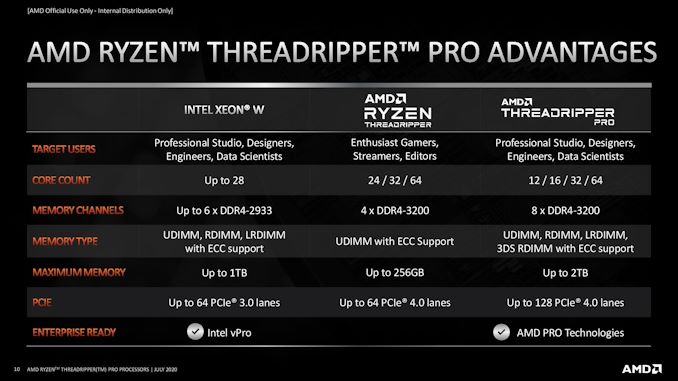
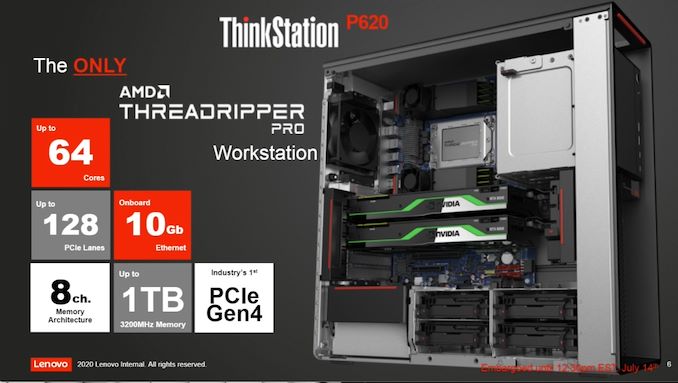
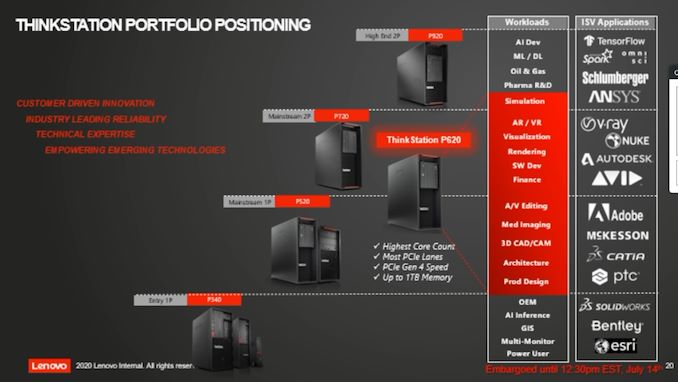
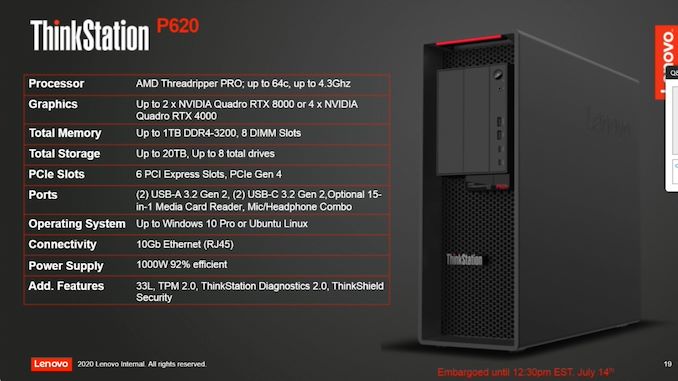
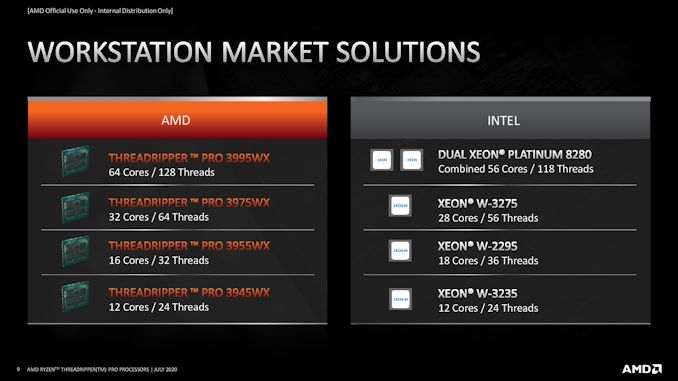
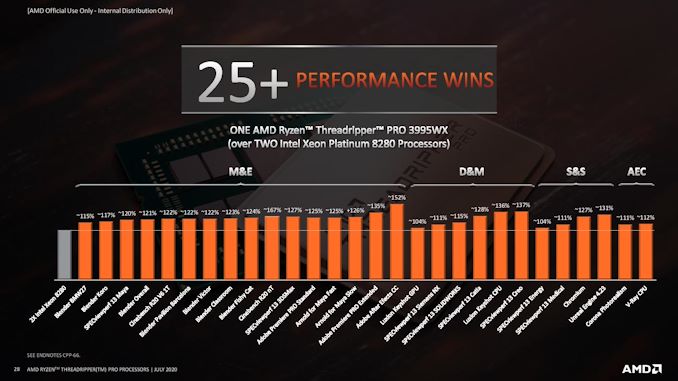








76 Comments
View All Comments
mczak - Tuesday, July 14, 2020 - link
This is technically correct, albeit I'm not sure they really suffer that much, since it's not like you could actually get all that bandwidth to a single core in any case.But yes, if you have a workload with 16 threads which require maximum memory bandwidth, with the 32 and 64 core chips it's possible to distribute the threads along all ccd/ccx (don't ask me if the scheduler would manage that) so that all memory bandwidth is available, whereas with the 12/16 core chips it's not.
Personally I'm not all that sure there's really much point in such a 8 channel configuration with a cpu with just barely above ordinary desktop-class performance in the first place, though...
lightningz71 - Tuesday, July 14, 2020 - link
I can only imagine that the two chiplet packages are aimed at software products that have a huge memory footprint, but don't particularly need massive amounts of throughput. Remember, Theadripper (base) is rather limited in maximum memory capacity, at a quarter of the max for this product.extide - Tuesday, July 14, 2020 - link
It's actually only 1/8th -- 256GB is 1/8th of 2TB.Makaveli - Tuesday, July 14, 2020 - link
You are both correct.What you posted matches the chart above. His post matches the P620 system above which is Limited to 1TB of memory.
Rοb - Tuesday, July 14, 2020 - link
AnandTech had an article about memory transfer speed and latency over Infinity Fabric: https://www.anandtech.com/show/14694/amd-rome-epyc... (three pages), and STH had something somewhere (that I couldn't find) that with fewer than 64 cores the Infinity Fabric remains in place for the remaining (operational) cores to use; so CPUs with less than the maximum cores have better IF speed (except for the few Epycs optimized for 4 channel, probably derived from Epycs where the IF didn't pass the testing).The new ThreadRipper MUST have some shortcomings with existing "H" and "F" series Epycs (beyond a higher TDP) as AMD isn't going to cannibalize existing lineups - still it shows that Milan must have some clear improvement (beyond RAS); finding a webpage spelling out the non-obvious differences proves elusive.
TeXWiller - Tuesday, July 14, 2020 - link
They could go with 3+0 and 4+0 chiplets with the more cache per core benefits. Memory bandwidth per core does increase as a function of disabled cores as well.extide - Tuesday, July 14, 2020 - link
Then you would not want to disable and entire CCX. What you are thinking is how the 7302/7302P are done -- 4 CCD's each with 2 cores enabled in each CCX. 4 chiplets, 2 CCX's each, 2 Cores/CCX. The Ryzen 3300X uses a 4+0 config with an entire CCX and it's L3 disabled.TeXWiller - Tuesday, July 14, 2020 - link
It's too bad the cache limitation exists within the selection of current models. AMD's spec pages indeed tell the story of reduced L3 caches with the 12 and 16 core models.Duncan Macdonald - Tuesday, July 14, 2020 - link
These Threadripper Pro CPUs look very much like repackaged EPYC CPUs. As they are intended for workstations the power limit and the frequency have been boosted (compared to EPYC server CPUs) and the memory has been limited to 2 TB. (As very few workstations are likely to have even 1TB this is not a significant restriction.)extide - Tuesday, July 14, 2020 - link
Yeah, I mean all of the Threadrippers are basically repackaged Epyc's. I bet these basically use the exact same socket (SP3) as Epyc as well.